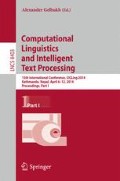Abstract
This paper discusses the generation of relational referring expressions in which target and landmark descriptions are allowed to help disambiguate each other. Using a corpus of referring expressions in a simple visual domain - in which these descriptions are likely to occur - we propose a classification approach to decide when to generate them. The classifier is then embedded in a REG algorithm whose results outperform a number of naive baseline systems, suggesting that mutual disambiguation is fairly common in language use, and that this may not be entirely accounted for by existing REG algorithms.
Access this chapter
Tax calculation will be finalised at checkout
Purchases are for personal use only
Preview
Unable to display preview. Download preview PDF.
References
Dale, R., Haddock, N.J.: Content determination in the generation of referring expressions. Computational Intelligence 7, 252–265 (1991)
Krahmer, E., Theune, M.: Efficient context-sensitive generation of referring expressions. In: van Deemter, K., Kibble, R. (eds.) Information Sharing: Reference and Presupposition in Language Generation and Interpretation, pp. 223–264. CSLI Publications, Stanford (2002)
Krahmer, E., van Erk, S., Verleg, A.: Graph-based generation of referring expressions. Computational Linguistics 29(1), 53–72 (2003)
Viethen, J., Dale, R.: GRE3D7: A corpus of distinguishing descriptions for objects in visual scenes. In: Proceedings of the UCNLG+Eval: Language Generation and Evaluation Workshop, Edinburgh, Scotland, pp. 12–22 (July 2011)
Paraboni, I., van Deemter, K.: Reference and the facilitation of search in spatial domains. Language and Cognitive Processes online (2013)
Krahmer, E., van Deemter, K.: Computational generation of referring expressions: A survey. Computational Linguistics 38(1), 173–218 (2012)
Dale, R., Reiter, E.: Computational interpretations of the Gricean maxims in the generation of referring expressions. Cognitive Science 19 (1995)
Pereira, D.B., Paraboni, I.: A language modelling tool for statistical NLP. In: 5th Workshop on Information and Human Language Technology (TIL 2007). Anais do XXVII Congresso da SBC. Rio de Janeiro, pp. 1679–1688 (2007)
Pereira, D.B., Paraboni, I.: Statistical surface realisation of portuguese referring expressions. In: Nordström, B., Ranta, A. (eds.) GoTAL 2008. LNCS (LNAI), vol. 5221, pp. 383–392. Springer, Heidelberg (2008)
de Novais, E.M., Paraboni, I.: Portuguese text generation using factored language models. Journal of the Brazilian Computer Society, 1–12 (2012)
Dale, R.: Cooking up referring expressions. In: Proceedings of the 27th Annual Meeting of the Association for Computational Linguistics, pp. 68–75 (2002)
Gardent, C.: Generating minimal definite descriptions. In: Proceedings of the 40th Annual Meeting of the Association for Computational Linguistics, pp. 96–103 (2002)
Arts, A., Maes, A., Noordman, L.G.M., Jansen, C.: Overspecification facilitates object identification. Journal of Pragmatics 43, 361–374 (2011)
Koolen, R., Gatt, A., Goudbeek, M., Krahmer, E.: Factors causing overspecification in definite descriptions. Journal of Pragmatics 43, 3231–3250 (2011)
Aziz, W.F., Pardo, T.A.S., Paraboni, I.: An experiment in spanish-portuguese statistical machine translation. In: Zaverucha, G., da Costa, A.L. (eds.) SBIA 2008. LNCS (LNAI), vol. 5249, pp. 248–257. Springer, Heidelberg (2008)
Cuevas, R.R.M., Paraboni, I.: A machine learning approach to portuguese pronoun resolution. In: Geffner, H., Prada, R., Machado Alexandre, I., David, N. (eds.) IBERAMIA 2008. LNCS (LNAI), vol. 5290, pp. 262–271. Springer, Heidelberg (2008)
Gatt, A., van der Sluis, I., van Deemter, K.: Evaluating algorithms for the generation of referring expressions using a balanced corpus. In: 11th European Workshop on Natural Language Generation, ENLG 2007 (2007)
Dale, R., Viethen, J.: Referring expression generation through attribute-based heuristics. In: Proceedings of the 12th European Workshop on Natural Language Generation, ENLG 2009, pp. 58–65. Association for Computational Linguistics, Stroudsburg (2009)
de Lucena, D.J., Pereira, D.B., Paraboni, I.: From semantic properties to surface text: The generation of domain object descriptions. Inteligencia Artificial. Revista Iberoamericana de Inteligencia Artificial 14(45), 48–58 (2010)
Paraboni, I., van Deemter, K.: Issues for the generation of document deixis. In: Procs. of Workshop on Deixis, Demonstration and Deictic Belief in Multimedia Contexts, in Association with the 11th European Summers School in Logic, Language and Information (ESSLLI 1999), pp. 44–48 (1999)
Paraboni, I.: Generating references in hierarchical domains: The case of Document Deixis. PhD thesis, University of Brighton (2003)
Gatt, A., Belz, A.: The attribute selection for GRE challenge: Overview and evaluation results. In: Proceedings of UCNLG+MT: Language Generation and Machine Translation (2007)
Dice, L.R.: Measures of the amount of ecologic association between species. Ecology 26(3), 297–302 (1945)
Passonneau, R.: Measuring agreement on set-valued items (MASI) for semantic and pragmatic annotation. In: Proceedings of the International Conference on Language Resources and Evaluation, LREC (2006)
Author information
Authors and Affiliations
Editor information
Editors and Affiliations
Rights and permissions
Copyright information
© 2014 Springer-Verlag Berlin Heidelberg
About this paper
Cite this paper
Teixeira, C.V.M., Paraboni, I., da Silva, A.S.R., Yamasaki, A.K. (2014). Generating Relational Descriptions Involving Mutual Disambiguation. In: Gelbukh, A. (eds) Computational Linguistics and Intelligent Text Processing. CICLing 2014. Lecture Notes in Computer Science, vol 8403. Springer, Berlin, Heidelberg. https://doi.org/10.1007/978-3-642-54906-9_40
Download citation
DOI: https://doi.org/10.1007/978-3-642-54906-9_40
Publisher Name: Springer, Berlin, Heidelberg
Print ISBN: 978-3-642-54905-2
Online ISBN: 978-3-642-54906-9
eBook Packages: Computer ScienceComputer Science (R0)

